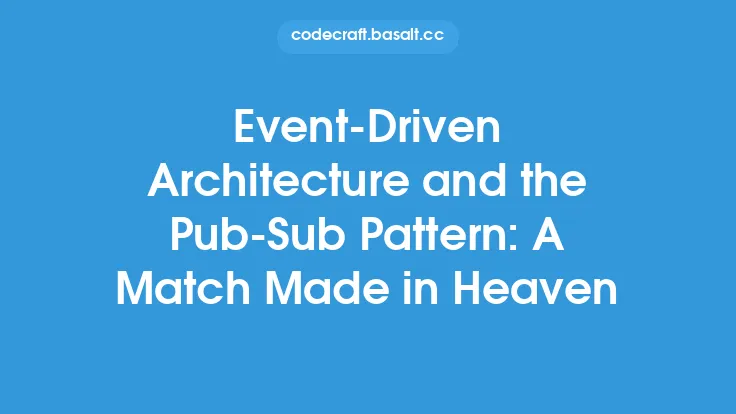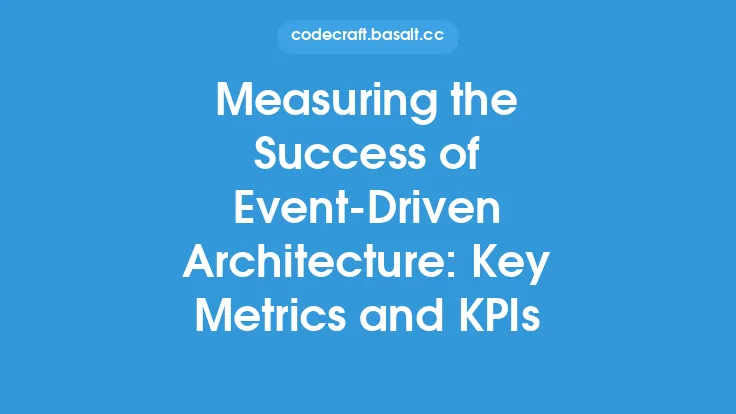The concept of event-driven architecture (EDA) has been gaining traction in recent years, particularly in the context of real-time data processing. At its core, EDA is a design pattern that revolves around the production, detection, and consumption of events. These events can be anything from a user clicking a button to a sensor detecting a change in temperature. The key idea behind EDA is to create a system that can respond to these events in real-time, allowing for more efficient and scalable processing of data.
Introduction to Event-Driven Architecture
Event-driven architecture is a paradigm that focuses on the creation, publication, and subscription of events. In an EDA system, components communicate with each other by publishing and subscribing to events, rather than through traditional request-response interactions. This approach allows for greater flexibility, scalability, and fault tolerance, as components can operate independently and respond to events as they occur. EDA is particularly well-suited for applications that require real-time processing, such as financial trading platforms, IoT sensor networks, and social media analytics.
Real-Time Data Processing in Event-Driven Architecture
Real-time data processing is a critical aspect of event-driven architecture. As events are generated, they must be processed and responded to in a timely manner. This requires a system that can handle high volumes of data, process events quickly, and provide immediate feedback. In an EDA system, real-time data processing is typically achieved through the use of event streams, which are sequences of events that are generated by a source and consumed by one or more sinks. Event streams can be processed using a variety of techniques, including stream processing, event-time processing, and batch processing.
Event Streams and Real-Time Data Processing
Event streams are a fundamental concept in event-driven architecture. They provide a way to represent a sequence of events that are generated by a source and consumed by one or more sinks. Event streams can be thought of as a pipeline of events that flow from the source to the sink, allowing for real-time processing and analysis. There are several types of event streams, including simple event streams, aggregated event streams, and windowed event streams. Simple event streams are the most basic type, where each event is processed individually. Aggregated event streams involve combining multiple events into a single event, while windowed event streams involve processing events within a specific time window.
Technologies for Real-Time Data Processing in Event-Driven Architecture
There are several technologies that can be used for real-time data processing in event-driven architecture. Some popular options include Apache Kafka, Apache Flink, and Apache Storm. Apache Kafka is a distributed streaming platform that provides high-throughput and fault-tolerant event processing. Apache Flink is a platform for distributed stream and batch processing, while Apache Storm is a real-time processing system that can handle high volumes of data. Other technologies, such as Amazon Kinesis, Google Cloud Pub/Sub, and Microsoft Azure Event Hubs, also provide real-time data processing capabilities.
Challenges and Considerations in Event-Driven Architecture
While event-driven architecture provides many benefits, there are also several challenges and considerations that must be taken into account. One of the main challenges is ensuring that the system can handle high volumes of events, particularly in real-time data processing applications. This requires careful planning and design, as well as the use of scalable technologies. Another challenge is ensuring that the system is fault-tolerant, meaning that it can recover from failures and continue to operate even in the event of errors. Additionally, event-driven architecture requires careful consideration of event sourcing, which involves storing the history of events in a database or log.
Best Practices for Implementing Event-Driven Architecture
To implement event-driven architecture successfully, there are several best practices that should be followed. First, it's essential to define a clear set of events and their corresponding handlers. This involves identifying the sources of events, the types of events that will be generated, and the components that will handle these events. Second, it's crucial to design a scalable and fault-tolerant system, using technologies such as Apache Kafka or Apache Flink. Third, it's essential to implement event sourcing, which involves storing the history of events in a database or log. Finally, it's vital to monitor and analyze the system, using metrics and KPIs to measure its performance and identify areas for improvement.
Conclusion
In conclusion, event-driven architecture is a powerful paradigm for building scalable and real-time systems. By focusing on the production, detection, and consumption of events, EDA provides a flexible and fault-tolerant approach to software design. Real-time data processing is a critical aspect of EDA, requiring careful consideration of event streams, technologies, and best practices. By following these best practices and using the right technologies, developers can build event-driven systems that are capable of handling high volumes of data and providing immediate feedback. As the demand for real-time data processing continues to grow, event-driven architecture is likely to play an increasingly important role in the development of scalable and efficient software systems.





